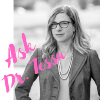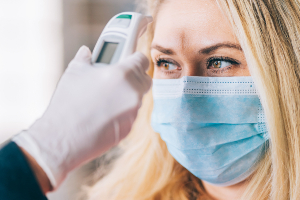 HAVE A QUESTION FOR DR. TESSA?
HAVE A QUESTION FOR DR. TESSA?
Email her your question at askdrtessa@ascpskincare.com.
“I’m receiving a lot of client requests for lip/chin waxes, which would require my client be unmasked for a period of time. Is this advised, and how much time can pass with my client unmasked before it becomes a liability?”
.jpg) We’ve all gotten a little hairy these days. COVID-19 spreads person-to-person between those in close contact with one another or by touching surfaces or objects that are contaminated with the virus and then touching your mouth, nose, or eyes. Close contact is generally defined as less than 6 feet, which would certainly be achieved with a lip/chin wax. The duration of that contact is an important determination of risk level.
We’ve all gotten a little hairy these days. COVID-19 spreads person-to-person between those in close contact with one another or by touching surfaces or objects that are contaminated with the virus and then touching your mouth, nose, or eyes. Close contact is generally defined as less than 6 feet, which would certainly be achieved with a lip/chin wax. The duration of that contact is an important determination of risk level.
The precise duration of time that constitutes a substantial exposure is also unknown, however the operational definition currently used by the Centers for Disease Control is greater than, or equal to, 15 minutes. A brief interaction is less likely to result in transmission; however, if your client is infected with the virus, the type of interaction will be an influencer (e.g., did they sneeze or cough in your face).
The need to have your client unmasked for a period of time is undoubtedly a risk, and if this is unacceptable to you, it is completely reasonable to suspend provision of these services at this time.
However, if you do provide facial waxing, there are several concrete steps you can take to minimize the risk:
- Ensure that your office is conducting a thorough pre-session health intake the day before the appointment as recommended in the ASCP Back to Practice guidelines. During this interaction, review the measures your office is taking to reduce risk and client expectations (such as wearing a mask, washing hands upon arrival, and/or using hand sanitizer). Let clients know you will be asking them to sign an informed consent that acknowledges their awareness of risks associated with the esthetic procedure (example language for the pre-session intake is provided in the ASCP Back to Practice guidelines.
- When your client arrives, administer the health screen checklist again:
- Have you had a fever in the last 24 hours of 100°F or above?
- Do you now, or have you recently had, any respiratory or flu symptoms, sore throat, or shortness of breath?
- Have you been in contact with anyone in the last 14 days who has been diagnosed with COVID-19 or has coronavirus-type symptoms?
- Use a no-contact thermometer to take the client’s temperature upon arrival.

- I highly recommend that your client wear their mask until the point at which it needs to be removed for the esthetic procedure and then have them put it back on.
- I would consider wearing a face shield as an additional barrier between you and the client, however it will need to be washed with soap and water and disinfected between clients. ASCP members can access discounts on PPE, including face shields. Learn more here.
- After the waxing, immediately wash your hands with soap and water for 20 seconds, leaving your mask in place. In your parting remarks to your client, calmly remind them that a waxing constitutes a potential exposure, so if they develop symptoms in the next two weeks, to please notify you.
- Once the client leaves, remove your mask (putting it in the trash if it’s a disposable surgical-style mask or in a container for daily laundry if it is a cloth mask). Wash your hands again for 20 seconds and put on a fresh mask.
Finally, take a nice deep breath. This is a scary time, however allowing our anxiety to build is not productive and will take a health toll. Make the decision that feels right for you, follow a safety protocol, and don’t ruminate too much. This virus may be with us for some time yet, so we need to alter our behaviors to reduce our risk and continue with the business of our lives.
REFERENCE:
- Centers for Disease Control and Prevention, “Implementation of Mitigation Strategies for Communities with Local COVID-19 Transmission,”
ASCP DISCLAIMER:
 Please be sure to always work within your scope of practice as determined by your state and to adhere to all local and federal rules and regulations regarding COVID-19 protocols. To learn more about returning to your practice or to access free resources to assist you with reopening, access the ASCP Back-to-Practice Guide!
Please be sure to always work within your scope of practice as determined by your state and to adhere to all local and federal rules and regulations regarding COVID-19 protocols. To learn more about returning to your practice or to access free resources to assist you with reopening, access the ASCP Back-to-Practice Guide!
 About the Author:
About the Author:
Dr. Tessa Crume is an Associate Professor in the Epidemiology Department at the Colorado School of Health at the University of Colorado Anschutz Medical Campus. Her research focuses on the development and utilization of public health surveillance systems to understand the burden of disease. She has been an academic researcher since 2011, before which she worked for a decade as an applied epidemiologist at the state and federal level, analyzing surveillance data and evaluating public health impact. Dr. Crume has taught the core epidemiology class at the Colorado School of Public Health for nine years.
HAVE A QUESTION FOR DR. TESSA?
Email her your question at askdrtessa@ascpskincare.com.
- Log in to post comments

 About the Author:
About the Author: